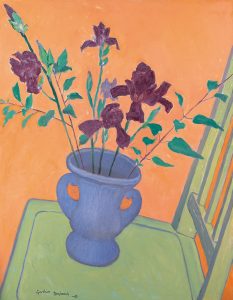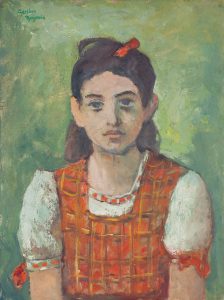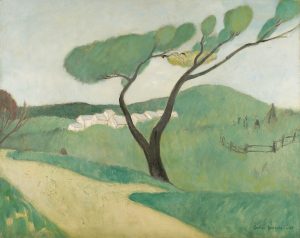Sixty-three years ago, a young student named Joan Facey ’58 visited the picture gallery in Drexel’s Main Building to unwind from her stressful studies. She was a freshman, an aspiring engineer — and also female, a fact that some of her professors never let her forget.
The College of Engineering during the mid-20th century in what was then the Drexel Institute of Technology was a lonely place for women, and not always friendly. Facey remembers a day, for instance, when she asked a question in class and the instructor ridiculed her — for 40 minutes. After matriculating its first woman in 1945, the college conferred degrees on just 24 more women over the ensuing 15 years; there were others who dropped out.

If it hadn’t been for the quiet breaks she spent in the gallery contemplating the University’s art collection, Facey is certain she wouldn’t have finished, either.
But she did, and today — and continuing through Aug. 7 — visitors passing through the Rincliffe Gallery on the third floor of Main Building will find a special exhibit that is Facey’s gift to students and her fellow alumni.
Titled Gershon Benjamin: Modern Master, the exhibit features more than 60 paintings and works on paper by the prolific 20th-century American Modernist. While the artist had no ties to Drexel, he shared a close 46-year friendship with Facey and her mother from the time Facey was 5 years old.
Facey is sponsoring the retrospective in hopes that Benjamin’s work may bring inspiration to others — just as The Drexel Collection did for her nearly six decades ago.
For Love of Art
From the moment Benjamin began studying art at age 10 until well into his old age, he painted or drew daily. He was a classically trained artist, friend and contemporary to famous painters such as Milton Avery and Mark Rothko, and a lover of art who immersed himself in the exhibitions and creative circles of New York. Art was his whole life, yet when he passed away his oeuvre was largely unknown.
Born in Romania in 1899, Benjamin emigrated with his parents and siblings to Montreal when he was 2 years old to escape the pograms sweeping Eastern Europe. In his early 20s, he settled in New York City and quickly became part of the 1920s art scene while holding a full-time position in the art department of The New York Sun.
During the Great Depression, when many American artists were supported by Roosevelt’s Works Progress Administration and favored social realism — which portrayed the everyday conditions of the working classes and the poor — Benjamin and his friends resisted the trend, deeming such artworks “doctrinaire.”
They were influenced instead by the European avant-garde. A signature of their style was the belief that art should express abstract ideas and universal feelings, rather than convey explicit picture messages.
Benjamin was part of a friendly circle of Art Student League students who met to practice drawing together with models they hired. They called themselves The Croquis Club (from the Spanish word for sketch) and their group included Adolph Gottlieb, Arshile Gorky, John Sloan and the Soyer brothers, among others. Together, they came to be referred to as Expressionists.
But while his contemporaries went on to fame as leading lights of the Abstract Expressionist art movement associated with the New York School, Benjamin sought his own creative path free of commercial influences.

“He believed that an artist should create his work out of an internal necessity rather than a desire to sell it, and throughout his life always distanced himself from opportunities to market his work or even to price it,” says Gina Greer, an art consultant and curator of the Benjamin exhibit.
He left behind an extensive collection of canvases bearing a style and skill that rival his famous peers.
“Two hundred years from now the name Gershon will be known as well as we know Van Gogh today,” Facey predicts.
Facey came to know the Benjamins in the late 1930s, when the artist and his wife bought a home near hers at Free Acres, a progressive artist community in Berkeley Heights in northern New Jersey. Benjamin would often use local children as models, or give them a pen and paper on which to draw when they visited his studio. Though Facey and her widowed mother weren’t materially well off, their friendship with the Benjamins enriched Facey’s childhood.
“His work spoke to me,” recalls Facey. The couple had no offspring, and they eventually asked Facey to oversee the Gershon Benjamin Foundation Inc. and be the executor of their estate and art collection.
Benjamin’s work as a rule has a poetical, pensive bent, though never descending to prettiness, and finds expression in a low-toned palette… His form is ‘felt’ rather than vigorously insisted upon, which gives his canvases…a certain aloofness and air of reserve…”
— Melville Upton, an art critic for The New York Sun, in 1937
The Engineering Connection
This spring two of Benjamin’s works have been on view in the College of Engineering’s office of the dean — a statement that at Drexel, artistic creativity and mechanical ingenuity have always gone hand in hand.
“The best engineers anticipate problems for society,” explains Bruce Eisenstein, vice dean of the College of Engineering. “What liberal arts gives us is an understanding of society, and the interaction between society and technology is where the new problems that need to be solved occur.”
At Drexel’s ExCITe Center, for instance, engineering students work alongside fashion design faculty on experiments with “wearable technologies” — such as textiles that store energy and knitted gloves embedded with mechanicals for hand injury rehabilitation. Drexel electrical engineers have also worked with museums, orchestras and theaters to program scenery changes, develop audience apps and make performances come alive. Recently, Drexel electrical engineers worked with a ballet dancer to create a dramatic visual effect of falling letters bouncing off her like raindrops as she moved.
One of the artworks displayed in the office of the dean depicts the Brooklyn Bridge quietly limned by sunrise. The other captures New York City’s rooftop skyline and water towers. Both are scenes of the city as Benjamin observed it often when returning home from work at dawn: silent, empty, contemplative — homages to progress through industry.

Gazing at them in his office one afternoon, Eisenstein remarked, “They look like they’ve always been here.”
And, of course, art has always been at Drexel.
When A.J. Drexel founded the institution as the Drexel Institute of Art, Science and Industry in 1891, one of his first steps was to give James MacAlister, the University’s future president, $1 million to travel to Europe and purchase artwork as part of the University’s educational mission. He believed that art was as important as what was learned in the classroom.
Those purchases became the flagships of The Drexel Collection, which now contains more than 6,000 objects including sculpture, drawings, paintings, ceramics and furnishings displayed across three galleries and throughout the Main Building.
The grandest of Drexel’s galleries is still the gallery in Main Building today known as the A.J. Drexel Picture Gallery.
It was here that young Facey found escape from the pressure of studies, prejudice and money worries. When she felt most drained, she would drag herself up the grand staircase and relax amid the masterpieces, magnificent grandfather clock and elegant antique furnishings. Sometimes, another student would softly play the ornate grand piano while she relaxed on a yellow brocade settee.
“As I put my books down, I also put down the burdens of the day, allowing beauty to fill the empty inner space,” Facey recalls.
She and her peers would have needed all the psychic support they could muster. In the ’50s, the College of Engineering had a “Marines mentality,” according to Eisenstein.
“It was like: We’re going to put you through hell and that’s how we can be certain you’ll survive in industry. They tried to get rid of two-thirds of the students,” says Eisenstein, who came to Drexel in 1965, when female students were still rare.
(Today, women make up close to 20 percent of the college; for more about the history of women in Drexel engineering, see the story in this issue on the origins of the Society of Women Engineers titled, “Where the Society Started.”)
[box type=”shadow”]
The catalogue for the Gershon Benjamin exhibit was designed by Drexel’s Graphics Group, a student-run design agency created about 10 years ago within the Westphal College of Arts & Design. Faculty advisor Mark Willie worked alongside Marisa Watanabe ’16, a junior studying graphic design, to produce the 72-page publication. The Graphics Group completes around 50 projects in a typical year, for which the students receive modest fees. “It’s a great addition to their portfolio and a little petty cash for them,” says Willie. “It’s a little business.”
[/box]
Indeed, Facey recalls one professor telling a lecture hall filled with freshmen: “Look to the man on your right and look to the man on your left; one of you may graduate.”
“It wasn’t a friendly place for women, but it wasn’t a friendly place for anyone,” Eisenstein says. “The Drexel model was tough, but it made you very strong on the job.”
Ultimately, Facey found a kind reception inside the Mechanical Engineering Department. “They were utter gentlemen,” she says of the department’s faculty. She coped with hostility from outside by forming a friendship with Robert Disque (pronounced Disk-way), who was then dean of the College of Engineering and had a few years earlier helped to launch Drexel’s nascent Society of Women Engineers.
With Disque, she recalls discussing the readings he required of engineering students while on co-op — 60 hours of mind-broadening readings in literature, history and other liberal arts, followed by a test. Some students disliked “The Disque Industry Reading Program,” and a few even failed to graduate on time because of the requirement, but Facey saw it for what it was.
“He opened up a world for me and it broadened my pretty wide interests even more,” Facey remembers.
Those memories lingered with her long after she graduated with a degree in mechanical engineering in 1958 — becoming only the University’s 18th female engineering graduate.
What followed was a long, successful career in the emerging fields of aerospace, cryogenics and industrial design working with companies such as Bell Labs and General Dynamics, where her Drexel preparation served her well.
“I saw myself in comparison with graduates from Princeton, MIT and Cal Tech in the aerospace industry, and I could see that I hit the ground running,” she says.

Her assignments included working on boosters used in intercontinental ballistics and parts used to launch the first astronauts. When IBM introduced the first commercial computers, she taught companies how to incorporate the new technology and ultimately became the first female manager for one of her clients, United Parcel Service, where she remained for the final 29 years of her career.
Today, she is retired and living in Clayton, Georgia, where she manages the Gershon Benjamin Foundation. In 2013, when she proposed this exhibit at Drexel, she composed this message to the current student body: “The marriage of art and engineering, the matchup of immense beauty and precise execution of time and space, created — although I did not know it then — a combination of interests that today fills my life. May this exhibition nourish you with its beauty as I was nourished by The Drexel Collection.”




